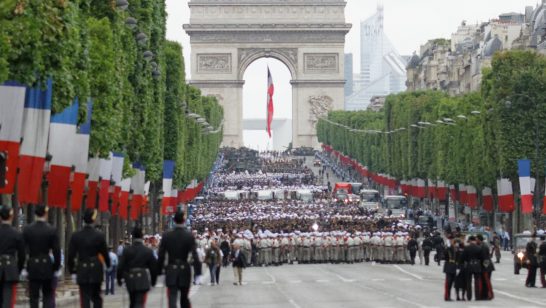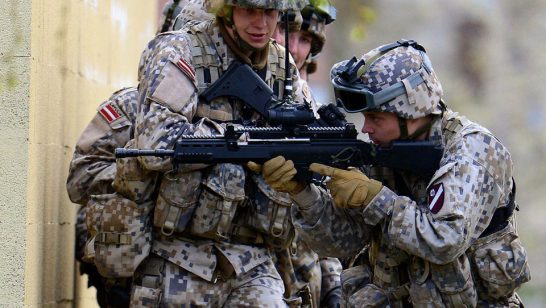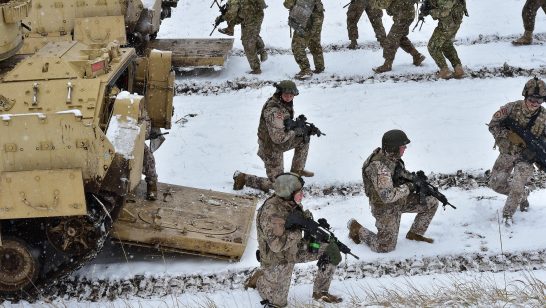
The weather is changing in Europe’s game of thrones. “Winter is coming”. As I take over at the European Leadership Network, the not-for-profit organisation dedicated to better security in greater Europe, Europe’s condition is more dangerous than at any time since the 1960s.
Whether or not President Trump will be as cavalier as Candidate Trump about US commitments to the security of European Allies, security risks on the European continent are rising.
To be sure, likely transatlantic strains don’t help. It isn’t just Donald Trump who thinks that Europeans aren’t pulling their weight in their own defence. Once the UK leaves, the 21 remaining EU member states who are also NATO Allies will provide less than 23% of NATO defence spending. On NATO projections, Europeans will still depend on the US to deliver more than one third of the Alliance’s defence capability into the 2030s and beyond.
But what Europeans themselves see most clearly are the mounting threats from the arc of instability around Europe’s south: the hammer blows from Daesh-inspired terrorism and unmanaged migration; the return of foreign fighters; humanitarian catastrophe in Syria. The strains inside the EU are evident. Meanwhile, Eastern Europeans focus more on the threats they see from Russia, just as Russia responds to the threats it feels from NATO. Miscalculation or accident between nuclear Russia and nuclear NATO is Europe’s greatest risk.
Yet dangerous as these things are, the coldest autumn winds are blowing through something less tangible and even more fundamental: Europe’s security cohesion. This is the web of treaties, arrangements agreed and understandings developed since the Second World War to ensure that Europe, the bloodiest place on the planet in the twentieth century, avoids tearing itself apart.
Not all the picture is bleak: counter terrorism collaboration has grown; cyber defences are slowly improving. And for all the lack of solidarity on migration, the EU may increasingly find collective solutions that better address migration’s root causes.
But the rules of the game and the levels of trust on hard security are fraying faster than ever. Russia and NATO blame each other. Moscow lays abrogation of the Anti-Ballistic Missile Treaty and the introduction of destabilising new military technologies at Washington’s door. It fears NATO’s expansion and ballistic missile defence plans. NATO points to Russia’s failure to withdraw forces from sovereign countries, its snap military exercises and its irresponsible nuclear threats. A particular mutual tragedy was the loss in 2007 of the adapted treaty regulating the levels and locations of conventional military forces in Europe.
The rot has accelerated since 2014. President Putin appears to see the West’s solidarity with Ukraine as a threat to his own regime. Russia’s annexation of foreign territory, corrosive information warfare and competition with the US in Syria have brought levels of mutual respect and cooperation to new lows. That great post-Cold War creation, the Organisation for Security and Cooperation in Europe is now almost paralysed. It was the guardian of much of the security transparency, predictability and risk mitigation on which the last 25 good years in Europe have rested.
Three basic, almost simple, things are needed to stop the rot and improve the weather.
- First, Europe’s leaders must accept the security problems to be as grave as they are and not as they might wish them to be. The sunlit years for much of Europe since the fall of the Berlin Wall in 1989 have bred complacency. The focus has been too much on European construction and not enough on problem solving. For example, the EU and NATO can and should attend more to their unfinished, neglected, business in the western Balkans. The Minsk agreements on Ukraine are sticking plasters on wounds that will not heal. Leaders must give deeper attention to how to manage the underlying, high risk, competition for spheres of influence.
- Second, Europe, North America and Russia must work collaboratively to restore the rules of the game or agree new ones. NATO Secretary General Stoltenberg is right to warn President-elect Trump that neither America nor Europe can go it alone. But, as Stoltenberg also regularly reminds us, while NATO unity and strength are necessary, progress is needed on NATO-EU collaboration, dialogue with Russia and the projection of stability to Europe’s south.
- Finally, states must mean what they say and say what they mean. No double speak. No casual speak. These things undermine cohesion and respect for the predictability, transparency, accountability on which Europe’s security has rested. Russia’s state-sponsored subversion of the truth is corrosive of trust in greater Europe and bad for Russia. But Europe also has legitimate expectations of President Trump and needs clarity about the long-standing commitments of the United States to Allies that Candidate Trump put in doubt.
Leadership networks like ELN can make a positive difference on all these challenges. They have policy generating capabilities, reach, flexibility, agility, and impact not always available to governments.
The opinions articulated above represent the views of the author(s), and do not necessarily reflect the position of the European Leadership Network or any of its members. The ELN’s aim is to encourage debates that will help develop Europe’s capacity to address the pressing foreign, defence, and security challenges of our time.



